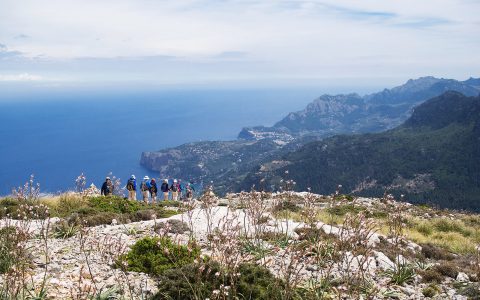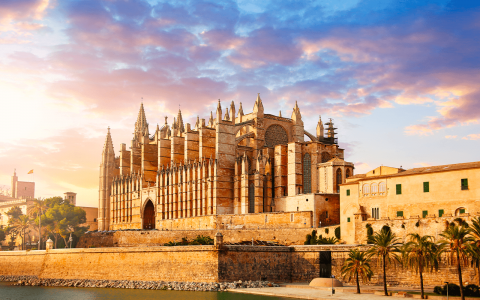Notes From the Road:
Mallorca Walking
The first time I visited the island of Mallorca in August 2010, for the first of many tours that I was to lead here, I was immediately enchanted by this amazing region.
The city of Palma is vibrant and really elegant. It hosts the biggest marina of the Mediterranean Sea, the best-preserved medieval walls of any harbour city in Europe, sandy beaches, great restaurants and hotels, a labyrinth-like city centre and one of the most impressive cathedrals in all of Spain. (It is definitely worth spending a few days in Palma before or after your trip!)

Even though Mallorca is world-famous for the deep-blue water and the white beaches, I truly believe that the centre of the island is as fascinating as its coasts. It’s authentic, quiet, clean and serene. The locals on this part of the island speak Mallorcan instead of Spanish, and they are incredibly friendly and welcoming.
Reaching the countryside is easy. As soon as you leave the city and head toward the centre of the island, you find yourself surrounded by olive trees, almond orchards, vineyards and charming little towns that have not been discovered by tourists yet. The blossoming of the almond trees of Mallorca is world-famous, comparable to the cherry trees blossoming in Japan, and the Mallorcan olive oil is among the best in the world.
See For Yourself
On our Mallorca Walking trip, experience incredible undulating coastal walks, secluded coves, the smell of citrus everywhere, and remarkable hotels in unforgettable settings.
DETAILED ITINERARYIn addition to the views of the mountain and the sea, the fascinating Mediterranean flora and fauna and the manors that one can visit along the way, what makes the hikes of Mallorca special is the possibility to move from a world-famous glamorous hotel like La Residencia (pictured below), immediately into areas that were basically isolated from the rest of the world until just a few years ago.

When it comes to winemaking, the only reason that I can find to explain why Mallorca is not world-famous for its wines is that hardly any bottles leave the island. Mallorcan reds are full-bodied, rounded wines. The best whites remind one of California, without being too “oaky.” The best place to taste them is the area between Benisalem and Biniali.
As for cuisine, in today’s Mallorca seafood is the way to go, but – somewhat surprisingly for an island – this hasn’t always been so. As a matter of fact, the islanders only developed a true fishing industry within the last 50 years. In addition to seafood, they are particularly proud of the way they cook lamb, which is considered the dish that represents the region, together with sobrassada and ensaimada.
I am a huge fan of both the simple, traditional Mallorcan food that one can taste at noon in one of the many menu del dia restaurants along the way, and the new, innovative, glamorous gourmet restaurants that have mushroomed in Mallorca, especially in Palma and in the region of the Tramuntana mountains.
If I sum up all the weeks that I’ve spent in Mallorca working as a guide, connecting the dots, preparing routes, sampling gourmet meals and wine tasting, the total time easily amounts to one year of my life. And trust me, it was one hell of a year.
Leave a Reply
MORE FROM Spain + Mallorca

Son Brull Hotel & Spa Embraces Sustainability in Mallorca
Mallorca
The Slow Fund: Commissioning New Instruments for Musika Etxea
Basque Country
9 Things to Do that Will Submerse You in San Sebastian
Basque Country
11 of Barcelona’s Most Spectacular Museums
Catalonia
What We’re Drinking:
Rioja’s Reds and Danish Akvavit
Denmark

Our Favourite Coastal Walk Right Now: Mallorca
Mallorca
The 10 Best Rioja and Ribeira del Duero Wines
Rioja
Reading for the Road: Our Favourite Books About Rioja
Rioja
Reading for the Road: Our Favourite Books About Catalonia
Catalonia
The 16 Best Luxury Hotels in Spain
Spain
Reading for the Road: Our Favourite Books About Andalucia
Andalucia
Mallorca’s Most Luxurious Hotels
Mallorca
Here’s How to Take the Ultimate Biking Trip Through Rioja
Rioja
The 7 Best Cycling Routes in Spain
Spain
Where to Eat: Our Favourite Costa Brava Restaurants
Catalonia
Basque Country’s 6 Best-Kept Secrets
Basque Country
Basque Country: Exploring San Sebastián & Bilbao
Basque Country
Granada: Last Stand of the Moors
Andalucia
Surreal World: Salvador Dalí’s Costa Brava
Catalonia



Thanks for sharing with us your experiences on Mallorca Island. Very good article about Palma de Mallorca! I recommend a train trip to Soller. Wonderful! I think it takes a few years to visit all offers Mallorca.